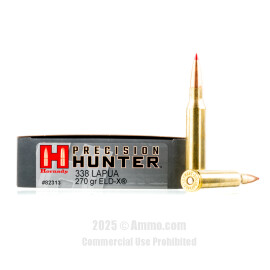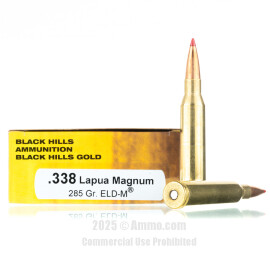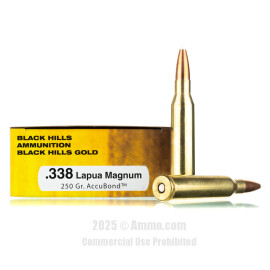
338 Lapua Magnum Ammo For Sale
Live Inventory
Overview of 338 Lapua Magnum Ammo
Research Armament Industries (RAI), an American company, was the first to introduce the concept of a long-range sniper cartridge in .338 caliber in 1983. Nammo Lapua Oy, commonly known as Lapua, joined the project to manufacture the casings for the ammo testing process. RAI withdrew from the program during testing, so Lapua started producing the whole cartridge independently.
The 338 Lapua Mag was designed for anti-personnel use, but it has also been used against light materials. Moreover, the round is powerful enough to penetrate concrete and target enemy combatants inside buildings.
How Does The 338 Lapua Compare To Other Calibers?
| Caliber | Recoil | Pros | Cons |
|---|---|---|---|
| 300 Norma | 338 Lapua has more | 338 Lapua has higher BC bullets and more stopping power | 338 Lapua has heavier recoil and worse trajectory |
| 300 PRC | 338 Lapua has more | 338 Lapua has higher BC bullets and more stopping power | 338 Lapua has heavier recoil and worse trajectory |
| 300 Winchester Magnum | 338 Lapua has more | 338 Lapua has flatter trajectory, more stopping power, and higher BC projectiles | 338 Lapua has more expensive ammo and heavier recoil |
| 338 Winchester Magnum | 338 Lapua has more | 338 Lapua has more stopping power, higher BC bullets, and flatter trajectory | 338 Lapua has heavier recoil |
| 338 Winchester Magnum | 338 Lapua has more | 338 Lapua has more stopping power, higher BC bullets, and flatter trajectory | 338 Lapua has heavier recoil |
| 300 Winchester Magnum | 338 Lapua has more | 338 Lapua has flatter trajectory, more stopping power, and higher BC projectiles | 338 Lapua has more expensive ammo and heavier recoil |
| 30-06 Springfield | 338 Lapua has more | 338 Lapua has flatter trajectory and more stopping power | 338 Lapua has heavier recoil and more expensive ammo |
| 308 Winchester | 338 Lapua has more | 338 Lapua has flatter trajectory and more stopping power | 338 Lapua has heavier recoil and more expensive ammo |
| 50 Browning Machine Gun | 338 Lapua has significantly less | 338 Lapua has much lighter recoil and better for hunting | 338 Lapua has worse trajectory and less stopping power |
Customer Reviews
-
Donald said:
Reliable and accurate
-
mike said:
super accurate out of my rifle...... makes me cry to buy it


























